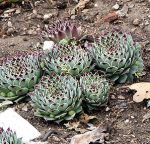 Hens and chick is an endearing plant that is very easy to grow and does well even with neglect; a perfect plant for a children’s garden! The plants grow 4-12″ tall and form a rosette of thick fleshy leaves that are are often pointed and may have purple tips. The rosette is often called the “hen” and sends out many horizontal stems that produce new plants called “chicks”. In summer, the “hen” produces star-shaped, red, yellow, or lavender flowers, dies, and the “chicks” take over so that the plant appears to live on in the garden forever. Even when a plant is removed from the soil and neglected for a long period of time it will revive when planted again thus giving credence to the idea that it lives forever. Numerous cultivars are available that vary most significantly in flower and leaf color, as well as leaf shape and texture. It is a good choice for a border, rock garden, crevices in a wall garden, and a container, as well as an edging or ground cover. Also known by such common names as common houseleek, St. Patrick’s cabbage, and Jove’s beard, the ancient Romans grew the plants on the roof tops to ward off lightning bolts thrown by Jupiter/Jove. In addition, the leaves can be eaten as a salad green. Native to the mountains of southern Europe and western Asia, hens and chicks is related to jade plant, kalenchoe, and Echeveria.
Hens and chick is an endearing plant that is very easy to grow and does well even with neglect; a perfect plant for a children’s garden! The plants grow 4-12″ tall and form a rosette of thick fleshy leaves that are are often pointed and may have purple tips. The rosette is often called the “hen” and sends out many horizontal stems that produce new plants called “chicks”. In summer, the “hen” produces star-shaped, red, yellow, or lavender flowers, dies, and the “chicks” take over so that the plant appears to live on in the garden forever. Even when a plant is removed from the soil and neglected for a long period of time it will revive when planted again thus giving credence to the idea that it lives forever. Numerous cultivars are available that vary most significantly in flower and leaf color, as well as leaf shape and texture. It is a good choice for a border, rock garden, crevices in a wall garden, and a container, as well as an edging or ground cover. Also known by such common names as common houseleek, St. Patrick’s cabbage, and Jove’s beard, the ancient Romans grew the plants on the roof tops to ward off lightning bolts thrown by Jupiter/Jove. In addition, the leaves can be eaten as a salad green. Native to the mountains of southern Europe and western Asia, hens and chicks is related to jade plant, kalenchoe, and Echeveria.
Type: Evergreen succulent perennial
Height: 4-12″
Bloom Color: Red, yellow or lavender
Bloom Time: Summer
Light: Full sun but tolerates light shade
Soil: Average (tolerates lean), dry to medium moist, well-drained; moderately salt tolerant; must not be over watered!
Hardiness: Zones 3-8
Photo Credit: Pamela J. Eisenberg Wikipedia